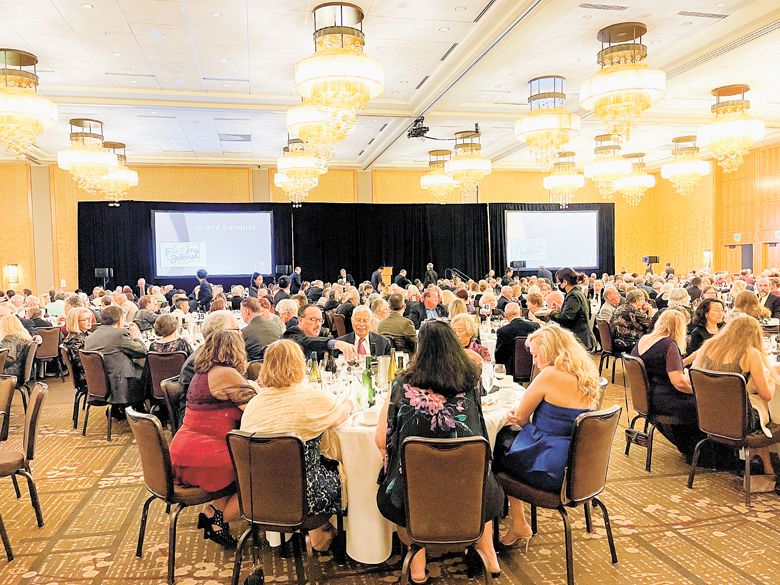Adult Ed

By Neal D. Hulkower
The American Wine Society, or AWS, founded in 1967, with significant help from Dr. Konstantin Frank, a pioneering vinifera producer in New York’s Finger Lakes region, remains the largest consumer-based wine education organization in North America. AES currently counts 150 chapters in 47 states and the District of Columbia, including one in Salem, Oregon. (Unfortunately, the Salem chapter ceased operating in 2019.) AWS membership numbers around 6700 and includes the entire spectrum of oenophiles, from novice tasters to wine educators, competition judges to grape growers, both amateur and commercial winemakers and wine merchants. While chapters host tastings throughout the year, the main event takes place at the annual National Conference. In late October, 515 registrants from 35 states and DC, including five from Oregon, gathered at the Hyatt Regency in Bellevue, Washington, to learn, taste, and mingle.
Opportunities to pursue certification as a wine judge or through the Wine & Spirit Education Trust, or WSET, became available the first day. For the next two days, I focused on seven of the 49 possible seminars. I chose to forgo those familiar, including “The Wine Simply Tastes Better,” hosted by Jim Bernau of Willamette Valley Vineyards, highlighting his latest environmentally-friendly releases. Instead, I focused on unfamiliar wines and growing regions from my first vinous loves but which I have mostly neglected in my ongoing pursuit of Pinot Noir.
“The End of the ‘Großlage’ in Germany” was led by Annette Schiller, an economist and owner of Ombiasy Public Relations and Wine Tours. I enjoyed German Rieslings in the 1970s but rarely drink them now, so it was a pleasure to revisit new vintages of old friends. We tasted six wines produced by Dr. Loosen and Robert Weil from the Mosel and Rheingau to illustrate the results from all levels in the classification. Though each brought back fond memories, I classify Loosen’s 2020 Erdener Treppchen Große Lage (Grand Cru) Trocken Großes Gewächs (GG) the standout.
Sofía Araya, winemaker for Viñedos Veramonte in Chile, presented “Chilean Cab Throwdown – You be the Judge!” We sampled three Cabernet Sauvignon blends from the Maipo and Colchagua valleys. The prettiest of the flight, the 2017 Neyen from Colchagua, produced a 50-50 blend of Cabernet Sauvignon and Carménère. Interestingly, Araya’s husband, Amael Orrego, is winemaker at Benton-Lane Winery in Monroe, Oregon. They now reside in Corvallis.
“The Pride of Piedmont: Nebbiolo, Barbera and Dolcetto” led the first of two seminars by popular educator Deborah Parker Wong, National Editor of the Slow Wine Guide US (for which I am a field coordinator) and Global Wine Editor of THE SOMM JOURNAL, among other notable positions. I enjoyed a lovely but still youthful 2016 Marchesi di Barolo Barolo del Comune di Barolo Nebbiolo.
My spirit consumption, more limited recently, made me eager to attend “Armagnac vs. Cognac: History, Production and Aging,” organized by Christine and Daniel Cooney, owners of Heavenly Spirits. We sipped and spat four pairs of similar age, one of each of the “contenders,” were sipped and spat. I preferred the two younger Cognacs and the two older Armagnacs, particularly the 25 year old Delord Bas.
Deborah Parker Wong returned to guide us through “New York Wines: Looking Beyond Riesling.” While I enjoy Riesling from the Finger Lakes, I appreciated sampling a Pinot Grigio and a Chenin Blanc from the North Fork of Long Island. A 2019 Montezuma Winery Voleur Lemberger from the Niagara Escarpment, co-fermented with 6 percent Grüner Veltliner, made for a pleasant revelation. I was also amused by the 2021 Lakewood Vineyards Bubbly Candeo created from the Cayuga grape, a cross of the Vitis labrusca hybrids Schuyler and Seyval Blanc, developed at Cornell University's New York State Agricultural Experiment Station in Geneva, New York. It reminded me of a Moscato d’Asti my kids used to call soda wine. But with almost twice the alcohol (10.15 percent), I wouldn’t have served it to them.
My first fine wine experience focused on classified growth clarets. I haven’t sampled any in a while, so with great anticipation that I sat in on “Exploring the Classifications of Médoc,” hosted by Bordeaux Wine Board Accredited Educator Robert Cavanaugh, also CEO of Adventure Wine. The flight of eight began with two examples of Cru Artisan wines. Though the name was created in the 19th century, it became the official classification in 2006, and relaunched in 2018.
According to the official Bordeaux website, the wines are from “autonomous, small- and medium-sized estates at which the manager is actively involved in the operations of his/her vineyard, produces AOC wines and sells the production that is bottled at the château.” I found the 2016 Château de Lauga Haut Médoc to be a good value at $25.
We then tasted one wine from each of the three levels of Cru Bourgeois: Regular, Supérieur and Exceptionel, before advancing to the Grand Cru Classé. The 2018 Château Cantemerle, while young, had an inviting, perfumed nose and nice palate. A 2014 Château Talbot, the most expensive and final wine of the flight, was still tight with lots of tannins. After this seminar, I was “sucking tree bark,” as we used to say after committing infanticide on clarets.
“South Africa’s New Age” was the last of the seminars. Joshua Orr MS of Broadbent Selections escorted us through six wines. I greatly enjoyed the 2020 Alheit Vineyards Cartology Chenin Blanc (90%) and Semillon from the Western Cape. The 2020 Beeslaar TAJ Pinotage from Swartland, a steal at $18, was described as the feminine counterpart to Kanonkop’s masculine offerings, both made by Abrie Beeslaar.
The Grand Banquet closed the meeting on the third night with AWS president Michael Wangbickler bestowing awards and recognition. Oregon’s 2021 Willamette Valley Vineyards Pinot Gris was one of the wines shared on the table that night.
Next year, the AWS will convene near the Gateway Arch in St. Louis, Missouri. For information, visit www.americanwinesociety.org.










